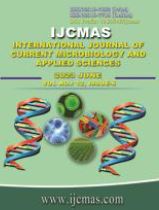


 National Academy of Agricultural Sciences (NAAS)
National Academy of Agricultural Sciences (NAAS)

|
PRINT ISSN : 2319-7692
Online ISSN : 2319-7706 Issues : 12 per year Publisher : Excellent Publishers Email : editorijcmas@gmail.com / submit@ijcmas.com Editor-in-chief: Dr.M.Prakash Index Copernicus ICV 2018: 95.39 NAAS RATING 2020: 5.38 |
The biological activity shown by fungal pigments is of significance for broadening their applications. In the current research, both cellular and secretory pigments produced by Aspergillus nidulans were separated by thin-layer chromatography (TLC) and detected by UV-Visible spectroscopy. The fractions were examined for their biological functions in terms of antimicrobial and antioxidant activities. The findings revealed that the crude cellular pigments had absorption maxima at 458 nm and 521 nm, corresponding to orange and red pigments respectively. The crude secretory pigments showed absorption maxima at 464 nm, representing orange pigments. In TLC, eight pigment fractions were separated in cellular pigment extract whereas nine pigment fractions were observed in secretory pigment extract. The crude cellular pigment extract was exclusively effective against Bacillus subtilis. The crude secretory pigment extract presented antibacterial activity on B. subtilis and Staphylococcus aureus. The crude cellular pigment extract had slight inhibition of Candida albicans whereas the crude secretory pigment extract showed inhibition against both Candida albicans and Cryptococcus sp. In the bioautography, the crude secretory pigment displayed inhibition activity on all the tested fungi whereas the crude cellular pigment extract revealed inhibition activity only against Curvularia lunata. Both cellular and secretory pigments showed antioxidant activity in a dose-dependent manner. The potential pigments with biological activity are promising candidates in the food and pharmaceutical industry.
 |
 |
 |
 |
 |